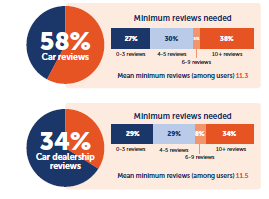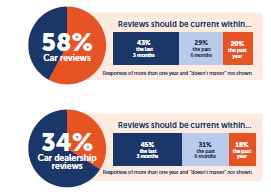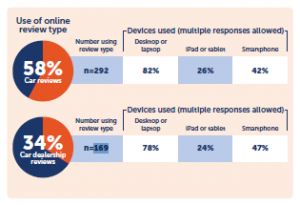Last week we discussed the value in your online reviews – how consumers use reviews and the role of positive and negative reviews. It’s important to the dealership’s success to have a strategy in place to monitor and respond to all reviews. Now, let’s dive into consumer behavior by looking at the number of reviews consumers want to see, how recent reviews need to be, and the devices used to read them.
What’s the minimum amount of reviews needed to influence a purchase decision?
Across categories, consumers want to read at least 4 to 5 reviews before making a purchase decision. We also found that one-third of consumers are wanting ten or more reviews to help them make a purchase decision. Think about it — what goes through your mind when you see a product or service with one review? Thoughts may range from, “It must not be good if there’s so few reviews” or “they must be new if there’s only one. I’ll keep looking.” The amount of reviews a dealer has available to consumers online matters — the more the better.
Customers think the same thing. Work hard to grow the amount of reviews for consumers to read, and keep them coming!
Those consumers who are frequent users of reviews expect more reviews than those who aren’t using reviews as often. Car reviews specifically are the second most useful type of review that we found, and car reviews have the largest amount of minimum reviews needed to satisfy consumers—with a mean minimum of 11 reviews being ideal to influence their purchase decision. Car dealership reviews are expected to have the same amount of reviews to be considered useful by consumers when choosing a dealership. If dealers have an effective online review strategy that prioritizes growing reviews, then this number shouldn’t be hard to achieve and it keeps fresh review content alive for an online audience.

How recent to do online reviews need to be to be deemed relevant to consumers?
When discussing recency, car reviews should be within the past six months to be considered useful. Across categories, however, consumers mostly accept reviews within 6 months to one year. Reviews within the past three months are ideal and are seen as having the most value.
Now, not everyone looks at the age of reviews, but for those that do, the more recent the better. Consumers want to make their decisions based on — practically — real-time information. Younger audiences, especially the Millennial generation, live in a world of instant gratification. If they can’t find what they’re looking for or don’t like what they find at a dealership, they’re likely to keep looking until they do. Dealers who don’t have enough recent reviews are going to lose in the marketplace when it comes to digital word of mouth.
Depending upon where a consumer is in their shopping journey, a review could be the catalyst to make a decision sooner. Dealers want to have their best and most representative foot forward to help consumers make that purchase decision — to buy from them.

What devices are consumers using to interact with reviews?
It’s interesting to see what devices consumers use to engage with reviews. You could assume that those who choose to write reviews on mobile devices are ‘in the moment’ and happy with their experience and want to write a review while it’s still fresh in their minds. On the reverse, they could have had an awful experience and want to vent. Either way, mobile is a means to review experiences and do it quickly. We found that 42% of consumers leave online car reviews via their smartphones.
In looking at dealership reviews, 34% of consumers leave them, but 47% of these reviews are done via smartphones — more than individual car reviews.
On the other hand, some consumers may choose a desktop to leave reviews. We found that because of the ease of use for some consumers or a lack of urgency to leave a review, a desktop may be more ideal for some consumers after purchase. For dealership reviews, we found that 78% of reviews are done on a desktop. We also found that 82% of car reviews written are done on a desktop as well.
For the largest purchases in a consumer’s life— vehicles and homes— they tend to use online reviews earlier in their research process compared to other purchases.
In any scenario, dealers need to create and execute a strategy to follow up with consumers after their purchase, asking for reviews of their experience to continue growing that digital word of mouth. Perhaps a consumer didn’t have a mobile device to leave a review when they were on the lot. Maybe the consumer meant to leave a review but forgot. Sending follow up emails, making phone calls, or sending texts can be a great way to continue growing dealers’ brands by asking the customer how happy they were with their experience and then asking for a review.





